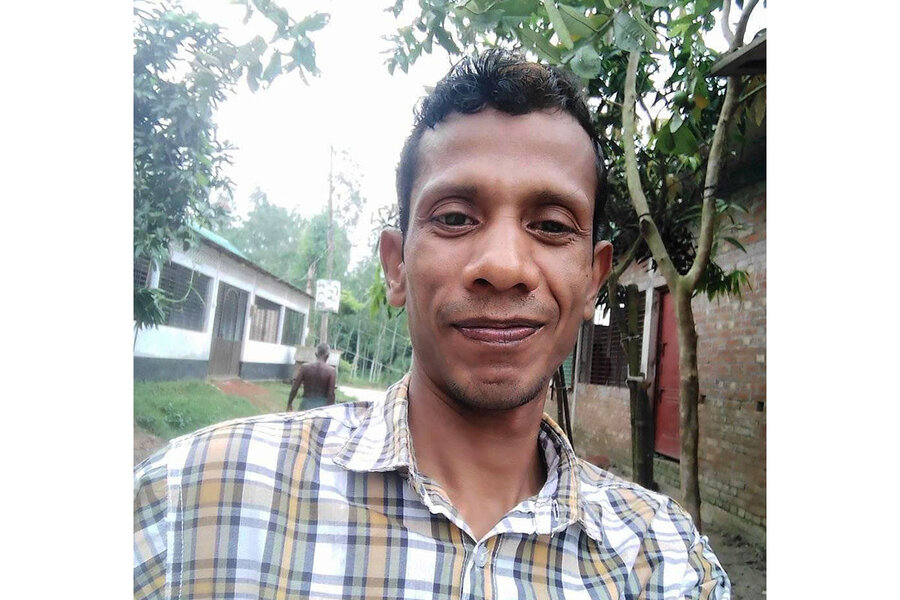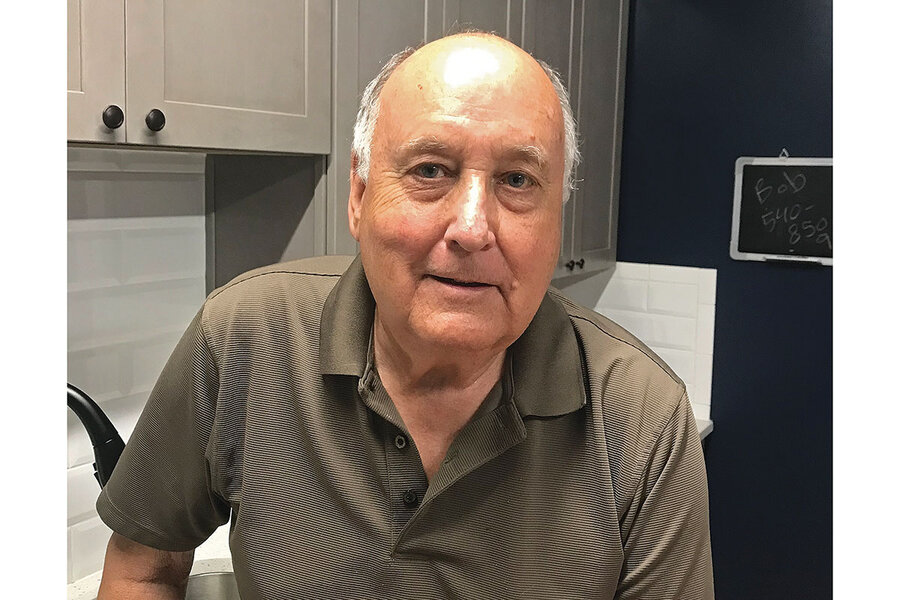How 9/11 ‘clash of civilizations’ brought East and West closer
Loading...
| Amman, Jordan
In 2009, teenager Lama Al Nasser came from Saudi Arabia to Michigan for a year of high school through an American government exchange created in response to 9/11 and the belief of an emerging West-East “clash of civilizations.”
Back home she was warned to expect racism “because I was an Arab, and especially Muslim,” she says. But, she adds, the small village of New Lothrop “was completely opposite to what I was prepared for.” She stayed with a loving farm family, played sports, volunteered, and soon knew everyone in town. “People were curious because they wanted to learn,” she says. “It really taught me not to have expectations or be judgmental.”
Why We Wrote This
The 9/11 attacks were, fundamentally, a shocking expression of clashing values. But, a generation later, under the radar of conflict, there is evidence of greater global understanding and common values.
Her experience in the post-9/11 boom in global, cross-cultural embraces suggests that rather than a clash, geographic and cultural boundaries between the West and the Arab and Muslim world have blurred. A meeting of minds has led to a recognition of common bonds and, increasingly, common values.
“There is no clash of civilizations; it has been debunked by social science and data, which has shown that most conflicts happen within a civilization, not between them,” says Jocelyne Cesari, a religion and politics scholar at the University of Birmingham in England.
Rezaul Karim can trace his English teaching career back to a single day walking back from the rice paddies in his village, Nizkabilpur Khiyarpara, in northern Bangladesh.
As he and his father approached the village store, they found a crowd gathering around a battery-operated TV.
Mr. Karim stopped and watched with the crowd, as a second plane hit the World Trade Center. People yelled in Bengali, “America is under attack!” as New York – a city he had only heard of in films – was in flames. He was struck by the horror – the words of the people being interviewed on the Manhattan streets stirred something inside him. He wanted to learn English. He wanted to know America.
Why We Wrote This
The 9/11 attacks were, fundamentally, a shocking expression of clashing values. But, a generation later, under the radar of conflict, there is evidence of greater global understanding and common values.
A letter to Voice of America resulted in booklets, pamphlets, a notebook, and pencil. With the arrival of electricity and internet in his village in 2010, he made American friends online – Thomas in Virginia, Paul in Texas, William in California – who sent him books on Texas cowboys and on Lincoln and Kennedy, and the classic “The Grapes of Wrath.”
The self-taught Mr. Karim became so proficient that despite not having obtained a college degree, he was employed as an English teacher – a post he held until the COVID-19 pandemic shuttered schools last year.
“Although I never visited, I have been touched by America and Americans,” Mr. Karim says.
Mr. Karim and his American friends are part of an increasing, friendly, global connection that flies under the radar of conventional wisdom that the 9/11 attacks were the first shot in a wider “clash of civilizations.”
Rather than a clash, whether by design, desire, or simple technological evolution, the geographic and cultural boundaries between the West and the Arab and Muslim world have blurred, as a meeting of minds has led to a recognition of common bonds and, increasingly, common values.
“The idea that the values between the West and the Muslim world are not the same as and are opposed to one another is historically wrong,” says Jocelyne Cesari, a religion and politics scholar at the University of Birmingham in England and a senior fellow at Georgetown University’s Berkley Center for Religion, Peace and World Affairs.
“There is no clash of civilizations; it has been debunked by social science and data, which has shown that most conflicts happen within a civilization, not between them. But this thinking persists because people often use stereotypes to base their views of the other,” she says. “Individual people are breaking the stereotypes by reaching out to one another. But what is missing is the political and religious leadership” to back it up.
After multiple global financial crises, a pandemic, democracy under threat, and United States-China competition, it may be hard to believe that at the turn of the century, before 9/11, a top concern in America was an emerging West-East cultural clash. Some politicians and pundits claimed it was a realization of what Harvard University professor and political theorist Samuel Huntington had coined in 1996 as a “clash of civilizations,” a future in which wars would not be fought between nation-states, but between warring cultures.
President George W. Bush characterized terrorist moves this way: “They hate our freedoms.” It was mistakenly applied by some to encompass an entire region, a belief that the West and the Arab and Muslim world had opposite, conflicting values.
An unexpected embrace
As a response to 9/11, U.S. institutions and the government initiated exchange programs, bringing Arab and Muslim students, journalists, and academics to the U.S. – a soft-power approach to a region where the U.S. was embroiled in multiple wars.
Lama Al Nasser is one of hundreds who took part. The Saudi clinical psychologist came to the U.S. as a 15-year-old for a year of high school through the Kennedy-Lugar Youth Exchange & Study Abroad program in 2009. She was to be an ambassador for her country, race, and religion in an America full of prejudices and stereotypes.
“People back home told me to expect racism because I was an Arab, and especially Muslim,” Ms. Al Nasser says. “Being in a small town means you stand out more. ‘Don’t be too close to anyone. Build your walls,’ they told me.”
Arriving from Riyadh in New Lothrop, a central Michigan village of 600, she says, “was completely opposite to what I was prepared for.”
She stayed with a loving family on a farm and soon knew everyone in town, and they her – from the gas station to the last house on the town limits. Curiosity about the first Arab and Muslim in town led people to welcome her, recalls Ms. Al Nasser: “People were curious because they wanted to learn. Everyone wanted to be friends with me because I was different. It really taught me not to have expectations or be judgmental.”
She engaged in sports from soccer to track – activities then mostly closed to women in Saudi Arabia. She surprised herself by taking second in a 100-meter race: “I never even knew I was good at sports because I had never tried before.”
Volunteering for Habitat for Humanity, helping finish a home for a family Ms. Al Nasser got to know, made her passionate about community service, which at the time wasn’t common in Saudi Arabia. In 2018, she founded We Dream, an association that provides catch-up education, entertainment, and psychosocial support to children and older people in Riyadh hospitals.
“Because of my time in the U.S.,” she says, “I learned that I have so much energy and I need to give to the community, to the people around me, and I carried that spirit with me back home. Deep down, we all want to give back to others less fortunate.”
Multifaceted communication
The past two decades have also seen an explosion in language exchange.
The number of American college students enrolled in Arabic courses doubled from 5,000 in 1998 to 10,500 in 2002, and has averaged 35,000 students over the past 10 years, according to the Modern Languages Association. Meanwhile, English, once an elective, is now a mandatory course from first grade in several Arab countries.
What started as breakthrough person-to-person exchange and diplomacy in the early 2000s have given way to mass connection through social media.
With the swipe of a smartphone, in real time, citizens around the world are connecting to news events and finding common bonds and causes, from climate change to social justice to cooking or gaming.
It’s a trend that has propelled people such as Turkish street drummer Bilal Göregen, who is visually impaired, into international stars. His viral performance of “Ievan Polkka” – itself a Finnish folk song – was seen more than 85 million times on YouTube, and even sampled by Democratic supporters of Joe Biden in the 2020 elections.
It may seem trite to older generations, but some members of Generation Z feel a unity in these viral cultural touchstones.
“We stream the same TV series, play the same video games, listen to the same songs; we use TikTok to express ourselves: We have more in common with members of our generation across the world than we do with the older generations in our own village,” says Amar Saeed, a Jordanian university student and self-described Call of Duty expert, who harbors hopes of becoming a “professional gamer.”
Facebook was the bridge that brought retired American air traffic controller Thomas Pesnicak into conversation with several Bangladeshis, including Mr. Karim.
“Rezaul likes America because he has had one-on-one contact with [me] and a number of different people across America on Facebook,” says Mr. Pesnicak, who has corresponded and video-chatted from Fairfax, Virginia, with Mr. Karim in his village regularly for a decade, and half-jokingly invites him to barbecue at his place every weekend. The American has sent the Bangladeshi books and a radio, and helped him pursue a college degree – and in turn, he has gotten to know Mr. Karim’s village.
“Hearing from regular people from different backgrounds with very different views gives someone a good sense of who we are,” much more than a government policy, military involvement, or politicians, says Mr. Pesnicak. “There will always be hard-liners at the edges of every society sniping at one another, but once people meet and talk, it breaks down barriers and opens up new worlds.”
Such connections also create a symmetry of activism. Amid the protests over the murder of George Floyd by a Minneapolis police officer last summer, Syrians painted murals of Mr. Floyd. And during violent protests and strife over the Palestinian cause this year across the Middle East, Black Lives Matter activists held protests across the U.S. in solidarity with them.
Similar connectedness is apparent to Ms. Al Nasser when advising Saudi students on what to expect as they head to the U.S.: “They tell me, ‘Yeah, we already know this.’ They have the ability to look everything up. They are much more aware than we were a decade ago.”
“All in this together”
Bridges of understanding are being created not only between people, but also through a meeting of minds among faith leaders.
The 9/11 attacks, described by Muslim and Christian faith leaders as a wake-up call, gave a jolt of energy to the faith community, leading to the broadening of interfaith connections from intra-Christian and Christian-Jewish outreach to include Islam, Buddhism, Taoism, Hinduism, and Sikhism.
What began as unified statements denouncing violence in the name of religions quickly grew into an exploration of common bonds and respect for one another’s traditions – and now, joint action.
One of the leading bodies is the G20 Interfaith Forum (IF20), a gathering of leaders and representatives across the world’s religions to discuss common challenges and solutions to climate change, racism, human trafficking, restrictions on religious expression, inequality, and, particularly, the response to COVID-19.
“Interfaith energy is going beyond dialogue, evolving from the mutual desire to recognize and respect each other’s histories, traditions, and contexts to work together in an increasingly bound-together planet,” says the Rev. Dr. James Christie, ambassador at large for the Canadian Multifaith Federation and an IF20 participant. “There is a sense that the world’s religious communities are saying we are all in this together.”
Last year the IF20 summit convened, virtually, from Saudi Arabia, the birthplace of Islam, and produced a statement on structural racism that noted, “The evidence of anthropology and the witness of our sacred texts conclude that all people share a common ancestry. We are all related. Our common heritage forbids that any might claim a racial pre-eminence over another.”
Despite differences, common bonds
But differences and, at times, tensions remain. Resentment over foreign policy still clouds the view of America for some, particularly the issue of Palestinian rights, U.S. military involvement in the region, and perceived U.S. support of oppressive leaders.
Similarly, the American view to the east has been clouded by violent extremism and the emergence of the Islamic State group (ISIS), and Muslims witnessed a spike in anti-Muslim sentiment during the Trump administration’s so-called Muslim ban.
Although global perceptions of the U.S. rose favorably at the time of 9/11, they have declined steadily since. What positive perceptions of America do exist rise and fall with changing U.S. administrations – driven by policy, not values.
Early in the Biden administration, before its abrupt withdrawal from Afghanistan, the U.S. enjoyed rising public favor in Morocco, Libya, Jordan, and Tunisia, according to Arab Barometer.
While individual and faith-based efforts to cross the apparent West-Islam divide are ongoing, they “have not gained the type of visibility that the clash of civilizations is still having in the public discourse,” says Ms. Cesari. “It is part of a public discourse that shapes policymaking to this day.”
The persistent belief that Western and Islamic values are not compatible fuels propaganda for far-right and extremist groups such as Al Qaeda and ISIS, each side “feeding off one another” in a bid to gain followers, she says, while common bonds are often lost in the political debate and media narratives.
Mr. Karim, the teacher, says he still faces criticism from some fellow Bangladeshis who believe the U.S. is “anti-Islam.”
“There are people in Bangladesh who still think that America and Islam can’t get along,” says Mr. Karim. “I have friends who criticize me for appreciating things about America and try to convince me that America is the enemy of Islam around the world, starting wars in Afghanistan, Iraq, and Syria.
“But from talking to American friends and reading the Constitution, I know that the law is open to everyone, there is freedom of religion for everyone, and there are Muslim communities – Muslim Bengalis living peacefully there for a long time,” Mr. Karim says.
“I tell them this: ‘The coin always has two sides,’ and people cannot be judged by the actions of one government or that of a few individuals.”











